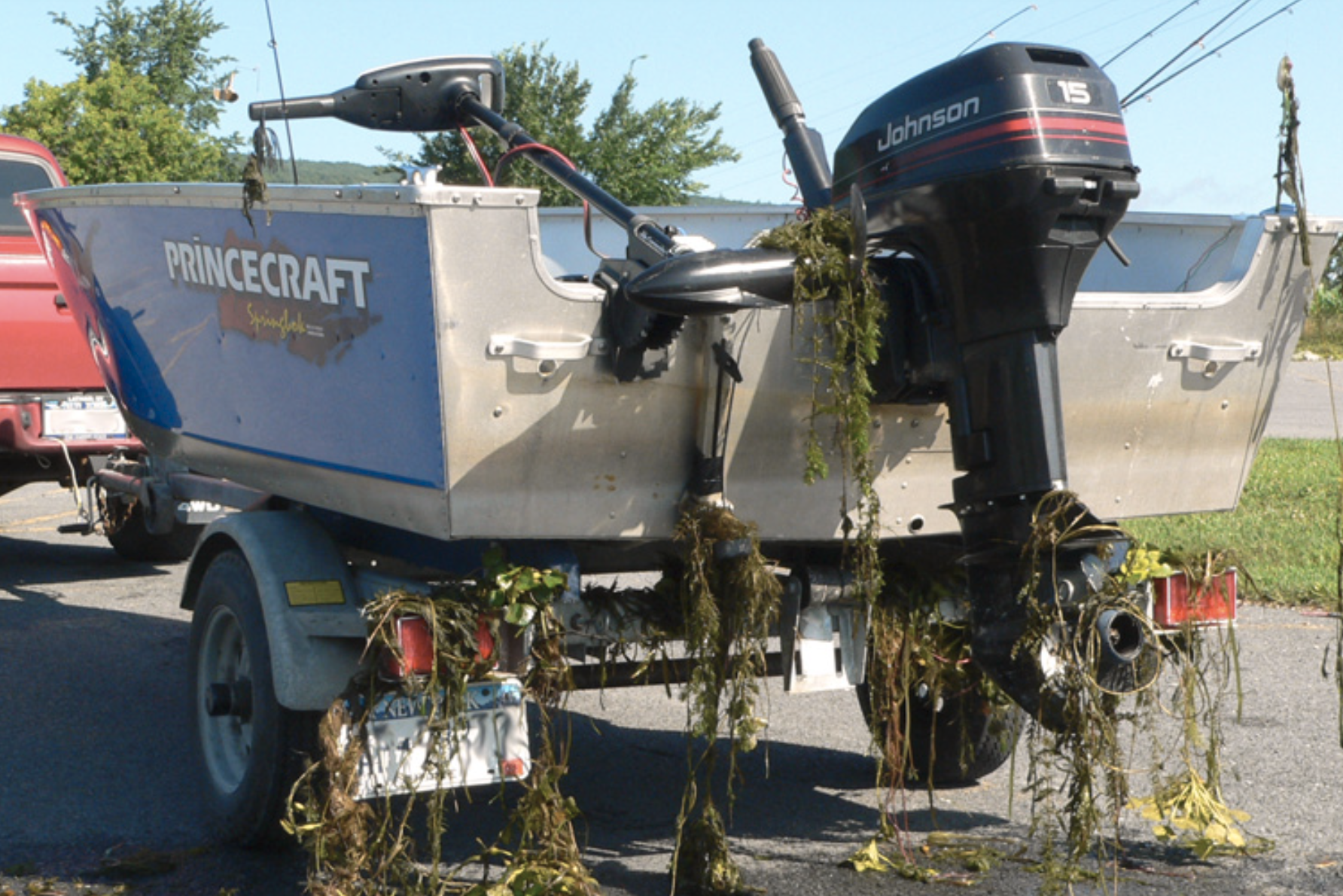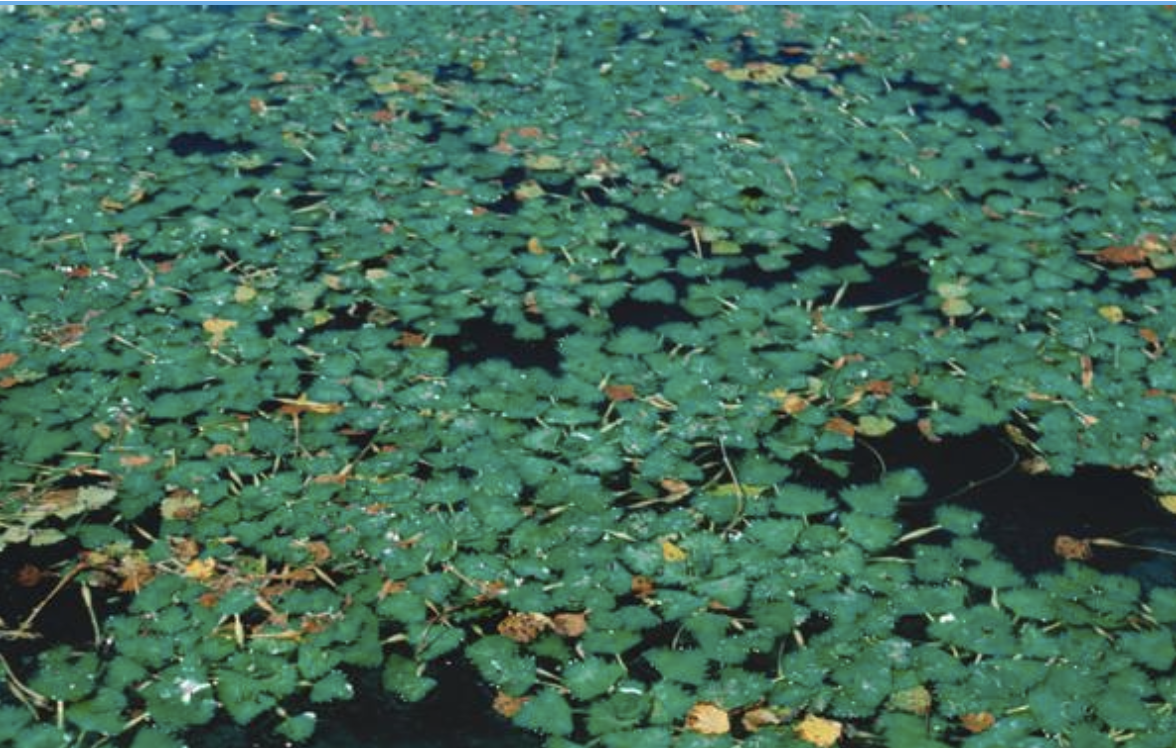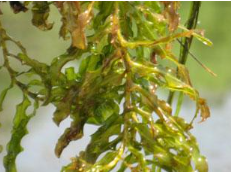
Invasive Species
Otisco Lake, like many bodies of water, is not immune to the threat of invasive species. These non-native species can have a detrimental impact on the lake's ecosystem, disrupting the delicate balance that has existed for centuries. One prominent invasive species in Otisco Lake is the Eurasian watermilfoil. This aquatic plant grows rapidly, forming dense mats that can choke out native plants, limit sunlight penetration, and obstruct recreational activities such as swimming and boating. In addition to watermilfoil, zebra mussels have also been a cause for concern. These small, filter-feeding mollusks reproduce rapidly and can attach themselves to native mussel species, power plant intakes, and other submerged structures. The invasion of these and other invasive species, such as curly pond and water chestnuts highlights the need for ongoing monitoring and management efforts to preserve the ecological health and recreational value of Otisco Lake.
Eurasian Watermilfoil
Eurasian watermilfoil is an invasive aquatic plant causing environmental challenges in freshwater ecosystems. Originally from Europe and Asia, it now occupies water bodies in North America. With long, slender stems and feathery leaves, it forms dense mats, blocking water flow and displacing native plants. Its rapid spread and adaptability make it difficult to control. Efforts include manual removal, herbicides, and biological control methods, all aiming to protect water ecosystems. https://nyis.info/invasive_species/eurasian-watermilfoil/
Methods for managing the growth of Eurasian milfoil
1. Manual Removal: One of the simplest and most straightforward methods to manage Eurasian milfoil is by physically removing it from the water. This can be done manually using tools such as rakes, nets, or specially designed cutters. By removing the plant and its root system, you can prevent its further spread and growth.
2. Mechanical Harvesting: In larger water bodies with dense milfoil populations, using mechanical harvesters can be an effective solution. These machines cut and collect the milfoil, preventing it from regrowing and reducing its overall presence. However, caution must be exercised to avoid damaging other aquatic plant species or disrupting the ecosystem.
3. Biological Control: Introducing natural predators or herbivores that specifically feed on Eurasian milfoil can be an environmentally friendly way to manage its growth. Fish species like grass carp or certain insects have been successfully used to control milfoil in some areas. However, careful consideration should be given to potential unintended ecological consequences before implementing this method.
4. Use of Herbicides: Herbicides can be employed to control Eurasian milfoil growth, especially in cases where manual or mechanical methods are not feasible. It's essential to choose herbicides specifically formulated to target milfoil while minimizing harm to other aquatic life. Professional guidance and permits may be necessary when using herbicides to ensure safe and effective application.
5. Preventative Measures: Prevention is key to managing Eurasian milfoil. Implementing preventive strategies such as thorough cleaning of boats, fishing gear, and other equipment after each use can help prevent the spread of milfoil to new water bodies. It is also crucial to raise awareness among recreational water users about the importance of responsible and eco-friendly practices.
Water Chestnut
Water chestnut is a rooted aquatic annual plant that has feathery submersed leaves that form a circular arrangement around the stem and green triangular like surface leaves with toothed edges that form floating rosettes at the end of the stem. It that dies back at the end of each growing season. Re-growth is by means of seeds that germinate in the spring. Each seed produces 10 to 15 stems with submerged and floating leaves, terminating in floating rosettes. The floating leaves also have prominent veins and short, stiff hairs on their lower surface.(https://nyis.info/invasive_species/water-chestnut/)
Methods for Managing the Growth
1. Early detection and monitoring: Regularly survey and monitor water bodies for the presence of water chestnuts. Early detection enables swift action to prevent their establishment and spread.
2. Mechanical removal: Implement mechanical harvesting methods, such as using specialized machinery or hand-pulling, to physically remove water chestnuts. This should be done before they produce seeds to prevent further propagation.
3. Chemical control: In cases of larger infestations, herbicides can be used under the supervision of professionals. Consult with local environmental agencies to ensure the correct and safe application of herbicides, adhering to all regulations and guidelines.
4. Consider biological control: Utilize natural enemies of water chestnuts, such as insects or pathogens, to target and suppress their growth. However, the introduction of biological control agents should be done cautiously to avoid unintended ecological consequences.
5. Dispose of harvested plants appropriately: Properly dispose of harvested water chestnuts to prevent them from reestablishing in nearby water bodies. Composting, incineration, or landfill disposal are suitable methods, depending on local regulations.
6. Prevention measures: Encourage boaters, anglers, and other recreational users to inspect and clean their equipment (boats, trailers, fishing gear) before moving to another body of water to avoid unintentionally spreading water chestnut seeds.
7. Public awareness campaigns: Educate the local community about the negative impacts of water chestnut growth and the importance of prevention and control efforts. Increase public awareness through workshops, signage, social media, and collaboration with relevant community organizations.
8. Collaboration and coordination: Establish partnerships between environmental agencies, conservation organizations, and local communities to share information and resources, enabling a coordinated and effective approach to managing water chestnut growth.
9. Long-term management plans: Develop and implement long-term management plans specific to each water body. This may involve a combination of different strategies, tailored to the unique characteristics and needs of the affected area.
Curly Leaf Pond Weed
Curly leaf pond weed has emerged as a serious concern in the intricate ecological balance of Otisco Lake. This invasive aquatic plant, native to Europe and Asia, has infiltrated our precious waterway, wreaking havoc on the local flora and fauna.
With its serrated leaves that curl at the tips, curly leaf pond weed presents a distinctive appearance that sets it apart from other native aquatic vegetation in Otisco Lake. It was first discovered in the lake several years ago, and since then, its growth has steadily escalated, posing significant challenges to the delicate ecosystem of the region.
While native aquatic plants function as vital components of the lake's ecosystem, providing oxygen, food, and shelter for various species of fish and invertebrates, the proliferation of curly leaf pond weed disrupts this delicate balance. Its rapid growth creates dense mats on the water's surface, limiting sunlight penetration and hindering photosynthesis for submerged plants below. Consequently, the oxygen production diminishes, endangering fish and other aquatic organisms that rely on it for survival.
Curly leaf pond weed also adversely affects recreational activities on the lake. The thick vegetation impedes boating, fishing, and swimming, diminishing the once vibrant experiences that Otisco Lake once offered to both locals and visitors.
Methods For Managing the Growth
1.Conduct regular monitoring of the water body to identify the early presence of curly leaf pondweed.
2. Implement physical control methods such as hand pulling or raking to remove the plants manually.
3. Consider using mechanical methods like cutting or harvesting to control larger infestations.
4. Introduce biological control agents which feed on curly leaf pondweed.Implement a herbicide program, if necessary, using approved aquatic herbicides specifically designed for curly leaf pondweed.
5. Ensure proper timing and application of herbicides following label instructions to minimize negative impacts on the lake ecosystem.
6. Encourage natural competition by promoting the growth of native aquatic plants that can outcompete curly leaf pondweed.
7. Educate the community about the importance of preventing the spread of curly leaf pondweed by cleaning boats and equipment before entering or leaving the lake.
8. Collaborate with local authorities, lake associations, and environmental organizations to develop long-term management plans for curly leaf pondweed.
9. Continuously monitor and assess the effectiveness of management strategies, adjusting the approach as needed to optimize results.






